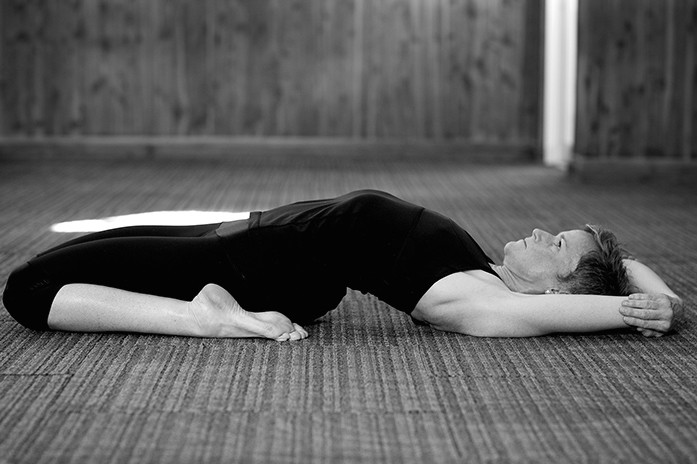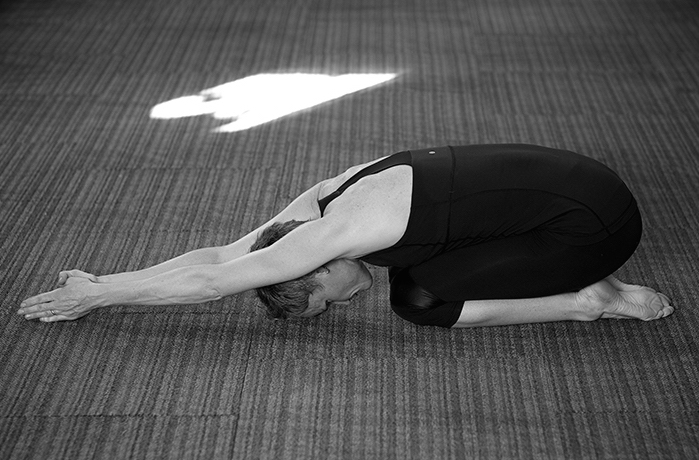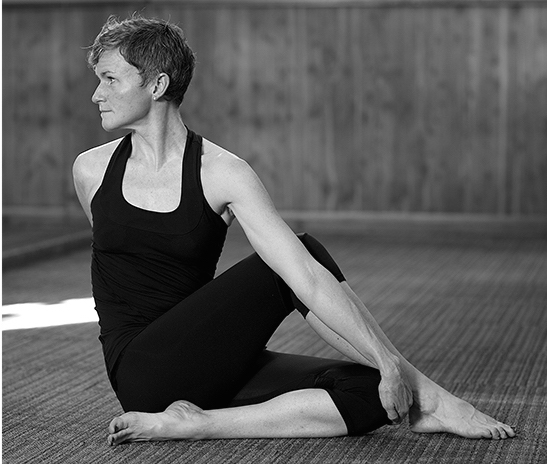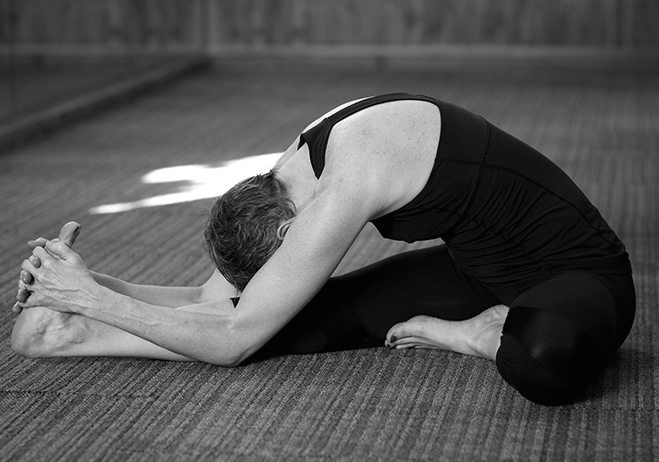There’s a lot to take in during a hot hatha yoga class. You’re trying to deal with the heat, the teacher is delivering a dialogue that describes the poses, and at the same time you’re straining to see what the person next to you is doing. It’s no wonder we miss a few things here and there. But after nearly 10 years of practicing yoga I’ve noticed a common set of mistakes that many Bikram yogis make (even those that have been practicing for years).
(A big thank you to Martha Williams, the owner of the Bikram Yoga Minneapolis studio for allowing me to use these photos of her perfectly executed postures!)
Leaning to the side in Triangle pose
It’s common in other styles of yoga to extend your arm and torso over the toes before turning your arms in triangle pose. You do not do this in hatha (aka Bikram) yoga. Keep your spine straight and rotate and stretch your fingers down to the ground from a straight spine position. You’ll notice this takes more core and inner thigh strength – this is intentional. If done properly this posture will build your inner thigh strength which helps with a gazillion other yoga poses. Also be careful not to turn your head to look over the tips of your fingers, this again is common in other styles of yoga. In hatha yoga, keep your head facing the same direction as your hips.
Skipping the set up in Fixed Firm pose

If you lean back in fixed firm pose, you may plop right into the second part of the posture, sitting your butt on the ground between your feet. To do this posture properly however, you need to start the pose sitting on your shins and feet first, then separate your feet and sit your butt to the ground. If you make sure to keep this important first step of the posture, you will maintain the proper hip, knee and ankle alignment. I was busted making this mistake some four years into my practice and was annoyed when the teacher called me out on it. I now see the important of doing the proper set up. It’s kind of like if you were to go back into camel pose without first leaning back on your hands.
Separating the knees in Half-Tortoise pose

This is so easy to do! Every time I practice this posture I have to tell myself to keep my knees together. It’s easy to let them separate once you’re in the full expression of the posture. You’ll have to use much more core and inner thigh strength to execute this posture properly.
Leaning to one side in Spine Twist

Again, people that have been practicing for years may not realize they are doing this. To have good alignment in spine twist, you need to make sure your weight is evenly distributed between your butt cheeks. When you twist, it’s easy to sink back into your back butt cheek without knowing it. I need to lean my weight towards the direction I’m twisting and only then is my alignment correct. This may mean that you have less depth in your twist, but you’ll get the full benefits of the posture.
Improper sequence in Final Stretching pose

It’s the end of class and you just want to be done! The first part of final stretching has an important sequence that will help those of you with inflexible hamstrings (like me). Once you’re legs are set up, turn to the right, lean forward to grip the bottom of your foot, inhale, and put your head to your knee. THEN pull your arms down to the sides of your leg. You should feel a more pronounced stretch in the backs of your legs.
Remember that yoga is a journey, our bodies are never the same when we arrive for class. It really doesn’t matter how “perfect” you execute the posture, what matters is that you work on the best possible alignment you can. I constantly am learning new things about the postures, how to do them properly and my body. That is the beauty of yoga, the only thing you’re required to do is show up, be precise as you can and work hard.
Never miss a post and join my mailing list.




Hi Lindsay Amazing articles. If you could explain Triangle (my favourite) a different way to me if possible. I cannot grasp the instructions explained but would love to understand this asana even a little bit more.
Regards & Thank you
Hi Catherine,
Happy to explain this in different terms. The main take away about alignment is that you should have your ankle, knee and shoulder in one line. Sometimes people extend their knee OVER the ankle, instead make sure these are in a straight line to protect your ankle. – Lindsay
Great article Lindsay, well explained and clearly written. (Lovely photos too!). Another common alignment issue I see is the heels crossed over or behind each other in standing separate leg head to knee pose. Those two heels like they are on a balance beam making it even doubly difficult to keep the hips in alignment. In the same posture the quickly bent front knee as they start to compress also deprives people of the incremental improvements they might get through compressing in first with the legs straight and then bending the knee if they head isn’t quite touching. Thanks for an informative article.